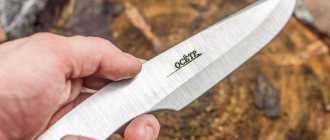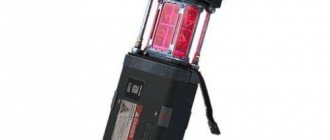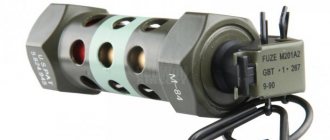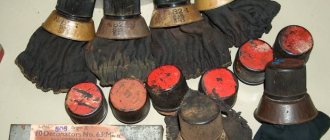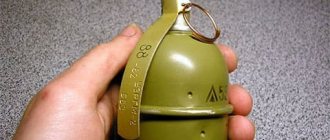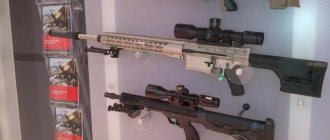Distance throwing
There are several ways to throw practice grenades. One of the most common of them is throwing grenades at a distance. This is done from a running start or from a standstill, at the discretion of the judges and organizers of the competition and passing the standards.
The projectile is a training grenade, the weight of which is 600 grams. Each participant has three attempts. If you perform this exercise in the army, then there will be special requirements for uniform. The uniform must be in field uniform with a machine gun in hand. In this case, some relaxations are allowed - an unbuttoned collar or a slightly loosened belt on the belt is allowed. At the same time, removing the headdress is strictly prohibited.
Throwing a grenade at a distance is carried out from a special bar; it can also be replaced by a line about 4 meters long. Attention is also paid to the quality of the runway. It should be dense, about one and a half meters wide, and at least 25 meters long. At the very end, in front of the bar from which the throw is to be thrown, the width of the track increases to 4 meters.
Additional exercises
Additional exercises are what you should start with before actively preparing to throw a grenade. They make it possible to prepare the shoulder girdle for future loads, as well as to involve in work those muscles and ligaments that often perform passive work.
As a result of this, the athlete manages to develop in just a few training sessions all the necessary qualities that will help give the grenade the necessary inertia when pushed.
Find out why physical activity is needed.
In professional and amateur sports, such exercises are divided into two main classes:
- leading - help the athlete develop the necessary technique of movements when throwing;
- developing - train the muscles and ligaments responsible for the force of the throw.
With the correct work of the coach, such exercises make it possible to develop in athletes:
- flexibility;
- coordination;
- movement speed and agility;
- mobility and strength of the shoulder joint.
A lot of exercises are used to prepare athletes. However, not many of them have gained real popularity among trainers and their students, since quite often the overly active involvement of passive muscles in the work leads to painful sprains.
However, today safe exercises that do not cause muscle and ligament sprains are also known.
Check out the best pre-workout warm-up exercises.
To develop the flexibility and muscles of the shoulder joint, use the following exercises:
- raising your arms in front of you to your shoulders (with or without additional weight);
- alternating dumbbell press from the chest up in a standing or sitting position;
- circular movements of the arms (with or without weight);
- moving the arms to the sides with the torso bent.
You can develop coordination by:
- turning the body to the sides with a vertical body position;
- alternate leg lifts parallel to the floor in a standing position;
- raising your arms and legs above you in a lying position;
- bending while standing with arms extended to the sides.
The following will help improve your speed and strength qualities:
- running from high and low starts for acceleration (distances up to 20 m);
- linear relay races with distances up to 15–20 m;
- throwing a medicine ball from behind the head with two hands;
- throwing a medicine ball at a target at a distance of up to 10 m.
Important! Each of the additional exercises should be performed for 4-5 approaches and with at least 3-4 repetitions.
How to set the results?
The throw is counted only if the grenade falls within the corridor without flying out across the width. In this case, the senior judge gives the command: “Yes,” and the athlete’s result is recorded in the protocol. Another condition is that the participant must not break the rules when making a throw, for example, do not go beyond the runway, do not step over the line.
The senior referee also raises the flag. Thus, he gives the command to the measuring judge to record the result. He makes a special measurement.
An attempt is not counted if the athlete violates one of the rules: touches the space beyond the line with any part of the body or equipment. And it doesn’t matter at the moment of the throw or immediately after it. Steps on or touches the bar itself.
The mark left by a grenade that fell into the corridor is marked with a peg. The athlete's results are measured using a tape measure. Accuracy is set to the nearest centimeter.
Measurements are not made immediately, but only after all three throws have been completed. The best result is recorded in the competition protocol.
If two or more athletes demonstrate the same results, then they are considered to have shared places. An exception to this rule is only when determining the winner. If several athletes with the same performance claim to win, they are given an additional three throws.
Throwing a grenade for accuracy
Throwing grenades in this way is also done from a running start or from a standstill. There are 3 circles located at a distance of 40 meters from the thrower. The central one is the most difficult to hit - its diameter is only half a meter, and this hit is awarded the highest score.
The radius of the second circle is one and a half meters, and the third is two and a half. The athlete’s main goal is to hit the very center of the target, in which a red flag is installed at a height of 30 centimeters from the ground. The uniform, as well as the size and weight of the practice grenade, are the same as when throwing a projectile at a distance.
Moreover, in order to hit the target, the participant is given many more attempts. Three only test shots and 15 shots in the standings. At the same time, the athlete is limited in time. He can train for no more than a minute, and throw scoring throws for a maximum of 6 minutes.
Technique: sequence of elements
Like any other sports discipline, grenade throwing has not only its own execution technique, but also subtleties that distinguish it from other throwing disciplines.
Therefore, before you begin to introduce an exercise into the overall training process, you must study in detail each of the individual stages of its implementation.
Video: projectile throwing technique
Holding the projectile
The correct grip of a grenade plays one of the key roles in giving the projectile the correct flight path, on which the final distance dramatically depends.
There are two types of grips:
- with a high center of gravity - the athlete grabs the projectile by the handle with four fingers so that the support of the projectile falls on the little finger (bent and pressed against the palm);
- into a fist - the projectile is compressed with all fingers of the hand, while its axis is directed perpendicular to the hand.
The first method is considered more preferable among athletes; it makes it possible to show good results for athletes with a developed hand. At the same time, the hand remains relaxed, thanks to which the athlete can easily control the position of the grenade during the throw.
Gripping into a fist is easier to perform and although it seriously strengthens the hand, it gives untrained athletes the opportunity to show decent results. This is achieved by lengthening the throwing lever during such a grip.
Takeoff run
During the takeoff run, the athlete reaches a certain speed, which is extremely important for giving the load the necessary inertia for a safe flight.
At this stage, the grenade must be at shoulder level, since only in this case is it possible to throw it successfully. In addition, only at shoulder level can the athlete most effectively control the position of the weight during the push.
We recommend reading about how to run correctly and quickly, and also find out how to warm up before running.
The takeoff run is divided into two main parts:
- From start to checkpoint. The duration of this path is about 10–15 m (8–10 running steps). At this stage, the athlete gains the speed that he will need to throw effectively. Such running should be accelerating, rhythmic, linearly directed, without sudden jumps.
- From the control mark to the throw bar. The final part of the running track is no more than 5–10 m long (about 4–5 throwing steps). Having reached the control mark, the athlete begins preparing to throw the projectile. The countdown for the final throw often begins with the left foot, thus, during throwing, the grenade will be able to impart the greatest pushing force. With the step of the right foot before the throw, the athlete needs to give the direction of the throwing arm an optimal position that will help the load acquire the correct trajectory.
Final effort
This stage begins after the athlete reaches the vertical, lowered through the base of the right leg until it rests on the left leg during the fourth step after the control mark.
The final effort begins after a forced rotation of the body position, so that the shoulders and pelvis are as parallel to each other as possible, and the hand with the grenade is perpendicular to the pelvis.
This position should take no more than one movement and be performed by the athlete instantly, otherwise the throw may not work. One of the most important elements of the final effort can be called the work of the left leg.
She should not:
- bend over, as this will dampen the speed gained during the run;
- accept an inclination of more than 60° to the GCMT projection (general center of body mass), as this leads to a sharp decrease in the force of the future push;
- go in discord with the right, as this sharply reduces the throwing power and flight range.
The final stage of the final effort is the push of the load. By this time, the athlete comes as close as possible to the throw bar. At the same time, his body stretches as much as possible and assumes the “bow thrower” pose.
In this position, the muscles of the shoulder girdle are maximally extended, which gives the load additional inertia when throwing. With the correct body position, joint work of the muscles of the arms, back and legs is achieved, so effective throwing includes only complex work of all parts of the body.
The dash has maximum impact on the grenade. At this stage, the athlete sharply directs his hand forward, which helps push the grenade into flight. In this case, the position of the grenade during the push is also quite important.
Did you know? Grenade throwing as a sports discipline originated in Europe in the 20s of the twentieth century. It was included in many comprehensive military sports training to train the general combat endurance of soldiers.
With the correct throwing technique, the elbow should come forward as much as possible at shoulder level, and the projectile itself should tilt at an angle to the horizontal of about 40°.
Maintaining balance after a throw
Maintaining the athlete's vertical position after the push is no less important than the others. Loss of balance often leads to athletes falling, which often results in injury.
In addition, in the world of athletics, loss of body balance is considered a technical failure, which leads to non-recognition of the results achieved. After throwing, the athlete retains the general inertia of the body, so it is quite difficult for him to stay on his feet after the throw.
A quick transition from the left foot to the right will help to sharply reduce the movement. In this case, you must point your toe slightly to the left - this creates a powerful braking effect that helps you instantly stop within one step.
Most often, athletes are given no more than 1–1.5 m for braking; if the boundaries of this segment are exceeded, the results are often not counted. Therefore, it is best to prepare for braking in advance; for this, the throw is made at a distance of 2–2.5 m from the final braking point.
Important! Learning to maintain balance after a throw should take place together with the study of the entire throwing technique, since during training athletes develop a persistent habit that is practically impossible to correct in the future.
Otherwise, the athlete may experience a loss of balance when braking, which is often compensated by swinging his arms. In the sports world this is unacceptable and always leads to a technical defeat.
Shot Evaluation
Throwing grenades at a target is judged by a judge who is in close proximity to the target. After each attempt, he evaluates the accuracy of the hit and raises the corresponding sign, also duplicating this information in his voice. Only after the throw has been scored is the next grenade allowed to be thrown.
Hitting each section of the target is worth a different number of points. For a grenade in the central circle, the athlete will receive 115 points, for hitting the second circle 75 points and, finally, for hitting the third - 45 points.
If a grenade hits a flag placed in the very center of the target, then no additional points are awarded for this. The athlete will receive 115 points.
The winners are determined in both the individual and team championships.
Tactics for using the F-1 grenade
History has not brought to us the name of the designer of the F-1 grenade. Developed before the First World War, it has so far proven to be the cheapest to produce and the most feared to use in combat. In Russia, Germany and Poland it was called “lemonka”, in France and England - “pineapple”, in the Balkan countries - “turtle”.
The grenade was developed on the basis of the French fragmentation grenade F-1 model 1915 (not to be confused with the modern F1 model with a plastic body and semi-finished fragments) and the English Lemon system grenade (with a grating fuse), supplied to Russia during the First World War. Hence the designation F-1 and the nickname “limon”. The grenade was adopted by the Red Army with a remote fuse (“fuse”) by Koveshnikov. Ignition of the remote composition primer is carried out by a striker action mechanism. In 1939, F.I. was modernized. Khrameev. In 1941, instead of the Koveshnikov fuse, the UZRG fuse of the E.M. system, which was easier to manufacture and handle, was adopted. Viceni. In addition to the “lemon”, the grenade was also nicknamed “fenyusha” by the troops.
With the advent of rifle-mounted and under-barrel grenade launchers, the art of fighting with hand grenades began to be forgotten. But in vain. The effect on the target of low-fragmentation grenades cannot be compared with the work of the F-1 hand-held fragmentation grenade, known to both the military and the civilian population under the code name “limonka”. With minor design changes, this grenade has been produced in different countries for 80 years. “Limonka” is the most powerful of all hand grenades in terms of the lethal effect of fragments and the most convenient to use. The ribs on its body - the turtle - exist not at all for division into fragments, as is commonly thought, but for “grasping” in the palm, for ease of holding and the possibility of being tied to something when placed on a stretcher as a mine. The body of the F-1 grenade is cast from the so-called “dry” cast iron, which, when a high explosive (crushing) charge explodes, splits into fragments ranging in size from a pea to a match head, irregularly torn in shape with torn sharp edges. In total, up to four hundred (!) such fragments are formed. The shape of the grenade body was chosen this way not only for ease of holding. Until now, no one can explain why, but when a “lemon” explodes on the surface of the earth, fragments scatter mainly to the sides and very little upward. In this case, the grass is “mown down” completely within a radius of 3 m from the explosion site, complete destruction of the growth target is ensured within a radius of 5 m, at a distance of 10 m the growth target is hit by 5-7 fragments, at 15 m - by two or three.
Therefore, at close distances, a bulletproof vest will not save you from an explosion—shrapnel will cut your arms, legs, and face.
Even a small fragment in the neck is tantamount to a death sentence. Small fragments retain a penetrating lethal effect up to 100 m, large fragments up to 250 m. In confined spaces, in addition to the mass of ricocheting random fragments, the shock wave of this strong grenade itself causes concussion and incapacitates. The bulletproof vest is also useless.
In the infantry, for all these reasons, the F-1 grenade is used as a defensive grenade. In special forces - as a powerful means of suppression, when with small forces it is necessary to achieve real results in specific brutal circumstances. The outcome in special operations when conducting combat operations in non-standard situations often depends on the use of practical combat techniques that are not specified in regulations and cabinet regulations. The merciless power of the lemon ensures a turn of events in favor of the proactive and inventive, but only with its skillful use.
During World War II, SMERSH employees (“death to spies” - military counterintelligence of the USSR during the war), when carrying out operational fire contacts, shooting while moving with one hand from a pistol, held a grenade in the other hand, raised at head level, as a counterweight for a smooth move. The grenade was thrown from this position without swinging, instantly, if necessary, thereby sharply increasing its firepower. But they threw for a reason. At close ranges of operational combat “point-blank”, in the event of a sudden collision with an enemy group, the grenade was thrown behind the enemy’s back. This protected the thrower from his own fragments. At the same time, the enemy found himself “sandwiched” between small arms fire “at point-blank range” and a grenade explosion from behind.
In close combat practice, this simple technique is difficult to overestimate. It is especially valuable in street battles, when when the enemy suddenly appears close, there is no time to swing a grenade or it is impossible in a cramped room.
Without swinging, a grenade can be thrown quite far and accurately, without taking your eyes off the target or intuitively in the dark. But for this you need to develop the joints and muscles of the throwing hand - be it the right or the left. With this development, you should: holding a full-weight training grenade (filled with sand) with your hand, swing it, simulating a swing and throw, all the time, increasing the amplitude of the swing and gradually moving back the starting barrier of the throw. From the starting barrier, the grenade is sent forward by sharp efforts not only of the arm, but also of the muscles of the shoulder, chest and abdomen, but do not throw the grenade! Pump back and forth until it stops, gradually moving the limit of this stop! This throwing technique is used when it is necessary to throw a grenade into a narrow loophole located above human height.
The grenade can be thrown quite far and directly from the belt or directly from the grenade bag with or without a swing from below forward. This method is very fast and valuable because the enemy often does not have time to understand that the grenade has “went” towards him. The enemy is used to seeing a throw with an overhead swing. Training and development of ligaments and muscles is carried out similarly to a throw without an overhead swing with a gradual distance from the starting barrier. When throwing from below without a swing, in the same way as when throwing from above, sharp, explosive efforts of the muscles of the shoulder, chest and abdomen are activated. The method is unusual, but with certain training the range and accuracy of the throw quickly progress. In addition, depending on the circumstances, it is sometimes easier to “roll” a grenade towards the enemy (for example, through low-lying slots) in this way. Throwing from below is practical during operational combat in buildings, when there is no need to send a grenade far, but sometimes you need to throw several grenades quickly one after another.
When throwing a grenade from behind a vertical cover (around a corner), which happens all the time during combat operations in various kinds of labyrinths, it is advisable not to lean around the corner and expose yourself to oncoming fire. The goal is determined intuitively or by ear. This method of throwing allows those who have trained to throw a grenade from below, from the waist, without a swing, to throw a grenade quickly, far and accurately, with both the right and left hand, because the same muscle groups are involved here, the development of which is carried out similarly to the above.
If it is necessary to throw a grenade while lying down along a horizontal loophole, it is thrown from the waist, if possible placing a stone, a duffel bag, etc. in front of you, whatever is at hand, as a temporary shelter for protection from your own fragments.
If there is a need to throw a grenade further, this is done from the kneeling position. To do this, from a lying position, they sharply push off the ground with their hands, pushing the torso and pelvis back so that the legs are bent at the knees. Accelerating the movement, rise to your left knee, placing emphasis on your right leg. This will allow you to make a wide backswing for the throw. Following the throw, fall sharply and “squeeze” into the ground. To master this technique, all the above-described movements are practiced repeatedly “idly”, without releasing the training grenade from the hand, making a wide swing, increasingly increasing the amplitude of the swing, gradually, as in the previously described throwing techniques, “pushing” back the starting barrier of the throw. When throwing from the knee, all the same muscles of the throwing arm, shoulder and especially the body are activated in a sharp, explosive manner. As you become trained, you need to achieve unity, simultaneity and speed of movements. Everything is done almost instantly.
If you throw a grenade this way from behind some kind of cover (a hump, a pile of rubble, etc.), your knees should not move. If you pull one leg forward while swinging, as beginners do, the movement will slow down, the thrower will involuntarily move forward and after the throw he may fall not behind the cover, but onto the cover with his chest. You need to learn how to rise sharply from the ground, throw a grenade, and fall sharply before the enemy is able to react and shoot. The method described above has always been used by scouts and fighters of assault groups when it was impossible to crawl close to the enemy without being noticed.
A similar method is used to throw a grenade into a horizontal slot, an embrasure located above the ground at waist level. But at the same time they throw the grenade, swinging it from the side along the horizon.
This is the most difficult target for grenade launching. Training the shoulder joint and the “throwing” muscles of the shoulder and core is carried out in the same way as in the cases described earlier.
After throwing a grenade, you need to retreat behind cover and hug it. There is no need to be curious about how your grenade will work - it will work without your participation. Don't fall under its fragments. Consider the direction of their possible ricochets. After the grenade explodes, count down in your mind “twenty-two, twenty-two” - this will be two seconds during which the fragments will go away or settle down, and do what you need according to the situation - dash in the right direction, shoot from a machine gun in dark corners, etc. In a specific assault situation, not only F-1 grenades are used. Anti-tank grenades - from the past war and especially modern cumulative ones - have monstrous destructive power and are indispensable when storming multi-story buildings, pillboxes, bunkers, etc. But they instantly go off when meeting any obstacle, and when throwing them you need to make sure that you have time to hide behind cover and close your ears before the grenade reaches its target. During training, this is determined by the sound of a dropped practice grenade. For the above reason, it is necessary to develop the habit of making sure that under no circumstances does the grenade hit anything when swinging, so that there are no bushes, branches, wires, etc. along the path of its flight.
SMERSH assault and sabotage groups used mines from an 82-mm Soviet mortar as special-strength grenades. They were four times heavier than the F-1 grenade, and therefore throwing them required great physical strength and additional training. But the effect of their use was terrible and exceeded all expectations.
Having mastered the above-described techniques of throwing grenades from various positions: lying down, from the knee, without a swing, etc., you should persistently train not only to accurately hit the target, but also to achieve the maximum speed of throws, so that in a combat situation you will not come under aimed fire or a stray bullet. To this end, when practicing grenade throwing, you should mentally count 2 seconds (to yourself - “twenty-two, twenty-two”) from the start of the technique, trying to release the grenade and fall behind the cover before this time expires. After these two seconds, the instructor training beginners fires a blank cartridge, simulating an enemy shot.
If the situation allows, grenades can be thrown with a strong swing from behind the head and even with a run - this significantly increases the throw range. In this case, throwing a grenade is carried out with the same natural movement with which each of us had to throw a stone. When training, learn to make a wide, free swing and put muscle strength not only in your arm, but also in your whole body, into the throw. When throwing while standing, put your right leg back and focus on it - this will increase the throw's distance. The greatest range is achieved if the grenade is fired at an angle of 45-50°. To do this, try to throw the grenade more up than forward. You can and should learn to throw a grenade over long distances. By training regularly, you can confidently reach distances of 50 m and beyond with lemon. The F-1 grenade range record, set in 1951, was 87 m.
Strong fragmentation F-1 must be thrown tactically competently. If it is impossible to “reach” the enemy with a direct throw, the grenade is thrown “on a ricochet” so that it bounces off something and falls closer to the enemy behind cover. A very difficult target to throw is a trench with a parapet. To defeat it, a grenade is thrown only in a suspended manner so that it either falls into the trench or rolls into it along the parapet. In this case, you need to throw the grenade not so much forward as upward, and the force of the throw should be calculated in such a way that the grenade is at its end and falls almost vertically from top to bottom. You should also throw grenades at enemy personnel located openly. Having fallen vertically to the ground, grenades roll less to the sides.
In the mountains, no matter where the enemy is relative to you - higher or lower, the grenade is thrown in such a way that it falls above the enemy and rolls into his trench or causes a rockfall that “covers” the enemy. In an open rocky area, if circumstances permit, it is better to throw a grenade up the slope not directly in front of you, but at an angle so that you yourself are away from the back rolling of the grenade and the direction of a possible shower of stones. In this case, it is necessary to take into account the safety of comrades located on the side.
Throwing grenades in the forest requires greater accuracy than in open areas. The specifics of the forest determine the throws of grenades at point-blank range. When dealing with an enemy hiding behind a tree, a grenade is thrown so that it explodes behind his back. To “get” an enemy dug in or lying behind a tree, a grenade is thrown up into the crown of the tree, where it is delayed by its branches and, falling vertically down on the enemy, explodes in the air or next to him (this is a nasty invention of German rangers, tested in the fight against partisans ). In wetlands, the pomegranate is thrown onto an island, hummock or shallow place. The thickness of the water significantly reduces the damaging effect of fragments.
When throwing a grenade at vertical high targets (windows), you need to take it higher, at the top edge of the target, since the grenade loses speed and gradually deflects downwards.
At running targets, grenades are thrown in anticipation, ahead of the target, in accordance with the speed of its movement, so that they fall in front of the enemy, and he runs at them at the moment of the explosion. It should be taken into account that during the burning time of the fuse (4 seconds), an enemy running at an average speed of 3-3.5 m/s will run 12-15 m.
Therefore, when preparing to repel an attack, it is better to outline a line in advance, upon reaching which the enemy should launch a grenade. This line should be 15-20 m further than the line to which the grenade can be thrown, taking into account its rollout after the fall. Grenades exploding in front of the advancing chain will force the survivors to stop and lie down.
They act in a similar way when the enemy runs away from you (when detained). The same should be done with a retreating enemy.
A special forces soldier has to throw grenades in the dark almost more often than during the day.
The night is never dark - it alternates with flashes of gunfire, artillery explosions, and flares. Having discovered a target with such a flash, it is recommended to immediately fix its direction and distance to it, tying it to some landmark, for example, a bright star, a tall tree or building that stands out against the background. A throw corresponding to a certain distance to the target is ensured by orientational-spatial efforts, familiar from a throw at the same distance during the day. Throw in muscle “dark” memory. This is the only way to throw a grenade at a given distance, and you can't do it better.
Trust familiar and practiced sensations - they are the ones that will never let you down. The development of such sensations and muscle-spatial memory occurs in a very simple way.
When throwing grenades from memory, our imagination should, as it were, illuminate the area of the terrain lying ahead, and allow us to mentally see the location of targets and other objects all the time. During daylight hours, the trainee looks at the target, then closes his eyes and throws a grenade. As soon as the grenade “goes”, the eyes open, and the result is visually tracked in order to take into account errors and coordinate the process. Knowing the results builds a skill. At the same time, the spatial-coordination and power sensations from the throw are clearly compared with its results. Corrections “right-left-closer-further” are made by changing the corresponding forces and the position of the grenade launcher relative to the target. All efforts and the general coordination state of the body at the moment of a successful throw are remembered by “dark” muscle memory and general coordination memory.
During subsequent throws, these efforts and coordination are reproduced by muscles and spatial memory when the imagination “illuminates” the area with the target. The method gives amazing results. With persistent training, success is achieved quickly, and the results of throwing grenades in the dark are no different from those achieved during the day.
Then, using the same principle, grenade throwing at hard-to-see targets is practiced. First, it is performed in the gathering twilight, then by the light of a fire, then in pitch darkness, focusing only on trained night vision and an animal sense of purpose. Only in this way will the trainee learn to find a barely noticeable target and correctly determine the distance to it in conditions of poor visibility (in smoke and fog). In this case, before throwing, as necessary for the educational process, the instructor illuminates the target with a flashlight beam for 1-2 seconds, no more. After developing solid muscle-strength spatial coordination skills, you can begin throwing grenades at targets, the location of which is determined in the dark by sound.
To determine the direction of the sound, trainees stand in a semicircle and close their eyes, the instructor silently moves in front of the formation and, stopping in one place or another, gives a sound signal - knocks the shutter, clicks the aiming bar, etc. The cadets are required, without opening their eyes, to point with their hand to the location of the sound source. Then the instructor allows you to open your eyes and check. Further, the exercise becomes more complicated - those who memorize with their eyes closed make several turns, and the sound comes from the side or behind them. It is necessary to determine the direction of the sound and the distance to it.
Grenade throwing is carried out at a sounding target with eyes closed according to the above-mentioned technique of “mentally illuminating” the target and applying muscle-coordinating efforts. When the grenade “goes”, you are allowed to open your eyes and coordinate the process.
Then the distance to the targets changes. Grenade throwing begins at night. Tin sheets are suspended inside vertical sounding targets (windows), which produce characteristic sounds when hit. To the right and left of the target, sheets of cardboard or plywood are hung, which, when hit, produce completely different sounds (different to the right and left of the target), which the grenade launcher is guided by, making corrections by hearing if he misses. The various milestones to the target are the same as during the day, so that the cadets can focus on the familiar muscle-coordination sensations of a throw.
The process becomes even more complicated. The target is a wooden frame with a sheet of tin pulled on a rope. The twine operates the “clanging” mechanism mounted on the frame. Despite the apparent difficulty of throwing a grenade at a moving target in the dark by ear, the results grow faster than one might expect. But that's not the point. As a result of training according to the method described above at night, throwing results during the day increase by 40-50%. This can be explained by the fact that in the dark, coordination internal reserves are mobilized, the coordination sense increases, and so-called “internal aiming” appears, which simply does not allow the thrower to throw a grenade into the wind.
As training progresses, the loads and options for grenade throwing increase. You must learn to throw a grenade far, quickly and accurately under any load and after any load in any difficult conditions. Try to quickly run 50-70 m and throw a grenade at a familiar, practiced target. What's it like? The effort expended while running will inevitably affect the range and accuracy of the throw. However, no matter what strenuous actions you perform before throwing (in a real combat situation they will certainly occur), no matter how tired and in a hurry you are, you still need to hit the target with a grenade! The combat situation is indifferent to excuses. Hit or missed. Yes or no. “Put down” someone or “put down” you. Learn to “catch” the target and determine the distance to it while running, while you swing. Gradually increase the distance and speed of running, alternate running with throws, hand-to-hand combat and shooting, crawling, carrying a comrade, etc. All this will have to be done in a combat situation. While practicing throwing grenades at windows and cracks, learn to make a rapid throw of 100-150 m, overcoming obstacles that may be encountered in the city - fences, fences, heaps of broken bricks, narrow holes, climbing walls and jumping off them. When practicing throwing grenades, accustom yourself to the unexpected - the enemy always appears suddenly and where he is not expected.
When throwing a grenade from a place and in motion, to complicate the exercise, stand with your back to the target, then, turning sharply, throw the grenade. When moving across rough terrain or in a populated area, set yourself a mental goal: to fire a grenade at a target detected with peripheral vision in a trench, in a hole, in ruins, behind anything that can serve as cover.
Exercises in throwing grenades will be more successful if you first perform throws for accuracy, and at the end of the training - for maximum range. Loads should be increased gradually, avoiding stretching of muscles and ligaments from excessive loads. Before training, the muscles need to be given a warm-up, rubbed, stretched and warmed up. At the end of the training, the instructor gives the cadets the maximum load through “I can’t”: “You can!” Forward!".
This is the general principle of dynamic training. Gradually, the grenade throwing time increases to 3-4 hours per training, from all possible positions, in all expected situations.
When practicing throwing grenades at all targets and under all conditions” at different distances, etc., after each successful throw, try to remember with muscular-orientational-spatial memory the efforts of the muscles, body, supporting leg and throwing arm. They themselves are very bright and fit very well into the “dark” muscle-orientation memory. Try to “get attached” to these sensations on subsequent throws. By doing this you program yourself for possible situations - you create a combat dominant.
In the situation of close operational combat, which changes every moment, there is no time to “turn on your brains” - you have to fight back using reflexes. The necessary reflex is produced by an internal dominant attitude programmed for a specific situation. During a battle to defeat, you have to rely on the combat support you brought with you, and on what you remove from the killed enemy. Fulfilling the requirement - not a single grenade misses the target - is not that difficult, and with persistent training you will wonder how it is possible to miss a grenade at all. The process of grenade throwing itself is a fascinating sport, biomechanically as close as possible to the natural instinctive movements of a person.
There is one more aspect. It is known that hand-to-hand fighters shoot poorly and are poorly trained in accurate shooting (sometimes there are pleasant exceptions to this rule). But thanks to physical and coordination training, hand-to-hand fighters in a very short time learn to masterly wield a grenade, throwing it very far, quickly and truly with diabolical accuracy. Moreover, the old-time special forces, aware of their shooting “Achilles’ heel,” sought to compensate for this deficiency with increased skill in grenade throwing. And they did the right thing from a tactical point of view.
Operational combat to destroy anywhere: in a city, in a forest, in any rough terrain - takes place mainly at a short distance. The short distance in this case is the grenade throwing distance. As practice shows, at such distances it is not the one who is bigger or who shoots better who wins. The winner is the one who has the most grenades, who uses them first, and who can throw them quickly, accurately and far. Hand grenades are pocket artillery. The F-1 grenade with its avalanche of fragments creates a denser kill zone around itself than an automatic burst. It is not always possible to stop an advancing chain even with dense automatic fire, but with the group use of lemons it is always possible. "Limonka" is cruel and merciless. Even if it doesn’t kill you with a shrapnel, it will concuss you, stun you, fill your eyes with sand, knock you down, knock your weapon out of your hands, in short, scatter the advancing formations.
When a reconnaissance group breaks through from a ring, grenades thrown simultaneously by each fighter in their sector and then thrown again after 10-15 steps make a hole in any chain of those around them; 12-15 F-1 grenades, thrown in the above manner along a front of 50 m and then 10-15 m deep, leave behind a blind spot, which those breaking through expand with automatic fire. At different times, many - both ours and not ours - broke through in exactly this way. Therefore, they tried to take the weight of the F-1 grenade as much as the number of cartridges they took. The hand grenade is a melee weapon. An indispensable weapon that has an undeniable advantage at short distances. A normal enemy is afraid of automatic weapons much less than of an “iron turtle” - you can dodge a bullet, but not a grenade. Grenade weapons are flexible. It is used when you need to reach an enemy holed up behind cover. A grenade can be rolled into any crack, thrown flat and vertical in any direction. The sight of a hissing grenade falling nearby without a ring plunges an experienced person into horror - he knows what will follow and tries to rush away from it for at least some kind of cover. And if there is no shelter, he dares to “kick” it to the side or even back to the sender (this also happens) - there is still no other way out. Therefore, a knowledgeable special forces soldier, having pulled out the ring and counted down the fuse for one second after the clap (in his mind - “twenty-two”) - you can’t tempt fate anymore, the UZRGM fuse does not always burn for the required 4 seconds - will throw or roll the grenade so that it stops about two meters -three from the enemy and he couldn’t reach her. All this needs to be worked out during training sessions.
Always be on good terms with a grenade. In a duel between a man and a grenade, the grenade always emerges victorious. The "Old Turtle" F-1 is a weapon too powerful to be allowed to fall into oblivion.
A. Potapov
Throwing technique
The first rule you need to know for the grenade throwing technique to be correct is how to hold the projectile correctly.
It is important to hold the grenade in such a way that the base of the projectile rests against the athlete’s little finger. At this time, the little finger itself should be bent and pressed as much as possible against the palm. The remaining fingers should tightly grip the grenade handle.
Another important point is the location of the thumb. It can be located both along the axis of the projectile and across it.
Read also[edit | edit code]
- Athletics disciplines
- Running exercises
- Jumping in athletics
- All-around athletics
- Classification and general characteristics of athletics exercises
- Athletics at school
- Athletics exercises
- Throwing in athletics
- Discus throw
- Javelin-throwing
- Hammer throwing
- Shot put
- Shot put technique
- Methods of teaching shot put technique
- Small ball throwing technique
- Throwing technique in athletics
- Rules for throwing competitions
- Athletics at school
Throwing exercise
In order to master learning to throw a grenade, experts advise performing certain exercises.
First. Stand in a standard stance with your feet shoulder-width apart. Raise the hand in which you are holding the grenade over your shoulder. Imitate a throw, alternately straightening your arms forward and up. Do this at least 9-10 times.
Next exercise. The starting position too. The training grenade can be replaced with a ball during training. Throw the ball on the floor and catch it after it bounces. Repeat the exercise at least 10-15 times.
Last tip. You perform a similar exercise with the ball bouncing, but this time from the wall, and then from the target, also drawn on the wall. At the same time, try to get as close to the center as possible. Make throws from a distance of 5-6 meters.
Exercises for independent mastery of rational technique[edit | edit code]
- Standing facing the direction of throwing, left leg in front, throwing the projectile with one hand down and forward, forward. The same thing, standing with your left side to the direction of the throw.
- Standing with your left side in the direction of throwing (body weight on your right leg), your left leg is raised above the ground. Simultaneously with placing the left hand, throwing projectiles from a place.
- Standing with your left side to the direction of the throw, your right leg crosses in front of your left. With a left stance and body rotation in the direction of throwing, imitation (without throwing) of “grabbing” a projectile and a “stretched bow” position. The same in combination with throwing a projectile.
- Standing with your left side in the direction of throwing (left foot forward). A cross extension of the right leg is performed in front of the left, after which the leg returns to its original position. The same, but after crossing the right leg, the left leg is placed in the step position for the throw. First, without turning, and then with turning the body in the direction of the throw and “taking the projectile upon yourself.”
- Standing facing forward, left leg in front, right hand with a projectile over the shoulder. Smoothly, on a count of 1-2, turning your torso to the right (to a position with your left side forward), straighten your arm with the projectile back. The same goes for moving your hand two steps while walking with your right hand.
- Retracting the grenade (ball) 4 steps. Performed from the starting position with the left leg in front, the projectile above the shoulder. Abduct the arm with the projectile two steps (the hand is just above the shoulder joint). The “cross” (third) and last step are performed by quickly placing the feet on the ground (accelerated). First in walking, then in slow running.
- Throwing with 4 throwing steps. Having assumed the starting position for throwing after 4 steps, successively “grab” the projectile, straighten up, step forward with your chest and, passing through the “stretched bow” position, release the projectile at a given angle with a whip-like movement of the throwing hand. As in previous exercises, reaching the “stretched bow” position is carried out through the efforts of the right leg, pelvic and torso muscles.
- Running the preliminary part of the run (6-8 steps) with your left foot hitting the control mark. The same thing, but with throwing steps and simulating the final effort.
- Stand with the projectile retracted, left leg in front. Running is steady or accelerated. At any part of the run, taking off into a cross step and quickly placing the left foot at point-blank range, throw the projectile. After the throw, maintain balance.
Throwing rules
The rules for throwing a grenade are not too complicated, but to achieve the best results, it is important to know some secrets.
High performance is demonstrated by athletes who choose the best way to grip the projectile. Moreover, this depends on the individual characteristics of the participant in the competition. There are several of them - finger length, arm strength, joint mobility.
The most important thing is to ensure that the grenade is securely fixed at the moment when the athlete is preparing to throw. At the same time, it is important to increase the leverage so that the center of gravity of your projectile is as high as possible in the thrower's hand.
Books on the topic
The technique of throwing grenades is described in detail in the book by V. Nikitin “Throwing a small ball and grenades at school: a textbook.” The publication describes the methodology for performing each stage of the throw. In addition, you can learn more about the arrangement of the sites, the types of equipment and the features of the competition. The book also talks about the most effective exercises for improving the technique of performing the exercise.
“Athletics: basic knowledge (in questions and answers).” Author – E. P. Vrublevsky. The book tells not only about throwing, but also other features of athletics in general. In addition, after reading, the athlete will learn the history of athletics, master many exercises, and acquire practical skills.
Also worth mentioning is a set of 16 illustrated posters “Athletics. Training in throwing sports equipment and balls.” This original guide will be useful for beginners to master the technique. Each illustration is accompanied by text describing the stage.
In conclusion, it should be noted that there are unconditional benefits of grenade throwing exercises - they train almost every muscle. Regular exercise can tone your entire body. The main thing is to systematically engage in discipline, improving your technique.
Athlete's run-up
An important element of fulfilling this element of passing the GTO standards is the athlete’s run-up before throwing a grenade. To prepare for this finishing effort, there are two ways. The decisive element before throwing is to correctly deflect the projectile.
Knowing these little tricks, you can achieve good results when throwing a grenade. The technique for performing the first method is to move the projectile straight back.
The second method of throwing is to move the projectile in an arc, first forward, then down and finally sharply back.
What affects throwing results?
An athlete’s excellent sports training does not always contribute to quick and instant sports results. There can be a lot of reasons for this, since the throwing range of a grenade can be influenced by several indirect factors at once.
First of all, the results most often depend on the initial speed of the grenade, which is set by the athlete. It is a consequence of the path of application of force and the speed of passage of this path. Consequently, the longer the athlete acts on the grenade, the less time and effort it needs to travel a certain trajectory.
Upon careful analysis of several grenade flight trajectories, it can be argued that the best results are observed among those athletes who manage to throw the projectile at an angle of 40°. Therefore, the closer to this value the position of the grenade during the final push, the greater the distance it will be able to overcome.
This phenomenon is explained quite simply: at this angle, the projectile is minimally affected by the force of gravity of the earth, as well as atmospheric resistance. As a result, the cargo is affected by a minimal amount of counteracting forces, which gives it the opportunity to fly a longer distance.
